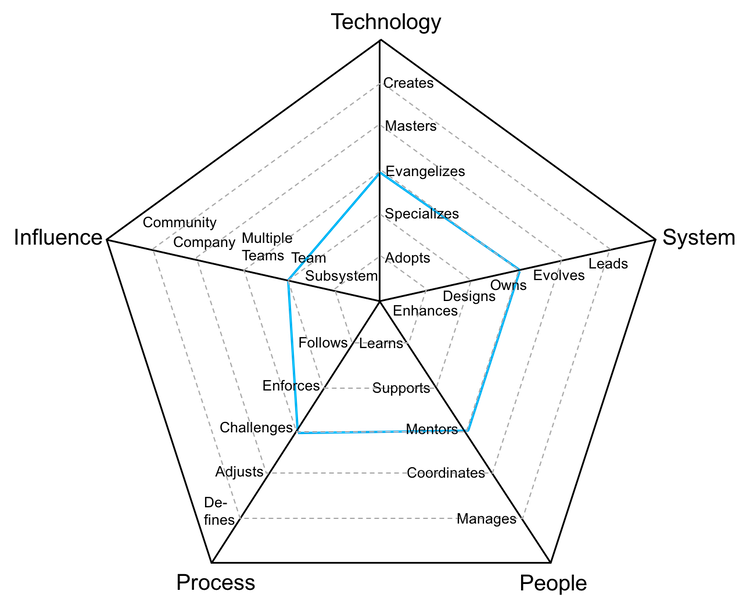
Engineering Ladders
TL;DR
Be the owner and driver of your career, understand the paths for growth in your role based on market standards, invest continuously in your career in an organized way, and follow a medium and long term plan.
Main links: Engineering Ladders , Dropbox Career Framework , and Progression.fyi .
Purpose
Engineering ladders are structured models in progressive levels that serve as a career guide, establishing clear expectations for each level. These levels consider criteria such as technical skills, impact, leadership ability, and collaboration, for example. They act as a compass, guiding professionals in their career progression and helping managers align expectations and support the growth of each team member in a transparent way.
Foundation
How many levels exist, and what are they?
There is no single rule in the industry defining how many levels exist, as each company has its own structure. However, a general pattern can be observed, these are the most common:
- Intern: typically students or recent graduates who are taking their first steps in the field. They have limited or no responsibilities.
- Junior: has some practical experience but is still developing fundamental skills. Responsibilities are generally limited to daily routine tasks. This level typically ranges from 0 to 2 years of experience.
- Mid-Level: has solid experience in their area of expertise and can mentor less experienced team members. They work autonomously and usually share responsibility for the systems developed by the team. This level generally requires at least 2 years of experience.
- Senior: has greater experience and technical expertise in their field, in addition to mentoring previous levels. They are usually responsible for the systems developed by their team or department and may act as a tech lead. This level generally requires at least 5 years of experience.
- Staff: combines advanced technical expertise and organizational influence. Typically, they work beyond their team, leading large-scale initiatives and collaborating with multiple teams to implement broader solutions. This level generally requires at least 8 years of experience.
- Principal: plays a strategic role in defining long-term technical directions for the company. They are generally responsible for cross-functional decisions and influence the evolution of processes and technologies. This level typically requires at least 10 years of experience.
- Distinguished Engineer: recognized for exceptional contributions and innovation. Their position and objectives vary significantly across companies, but generally, they operate at the organizational level, influencing standards, culture, and long-term vision.
It is important to note that some companies may use Staff and Principal differently depending on their organizational structures. Additionally, the timeframes suggested here are only general references and not strict rules. Small or medium-sized companies may not have all levels.
Many companies define their career ladders using numerical levels instead of job titles. You can explore the levels of major companies at Levels.fyi .
Where can I find these engineering ladders?
Engineering ladders are commonly found in large technology companies, often, but not exclusively, linked to a performance evaluation process. However, there are two key points to consider:
- Smaller companies or those outside the tech industry: Many of these companies have little or no formal career ladders, meaning you will need to rely on industry practices to guide your professional development.
- Companies may have an internal focus: Even in companies with well-defined career ladders, the structure may be designed to meet internal organizational needs. This means that expectations may not fully reflect market trends or demands.
For this reason, it is essential that you do not limit yourself to your company’s vision. Seek to understand various industry models to identify common career progressions, the required skills, responsibilities, and expected impact at each level. This way, you will be prepared not only to grow within your current company but also to seize opportunities elsewhere in the future. Staying aligned with the market ensures that your career path is strong and adaptable, regardless of the organizational context.
There are many different models, in this guide, we will explore two good ones, but you can find many others at Progression.fyi .
Model 1: Engineering Ladders by Jorge Fioranelli
This is a visual model created by Jorge Fioranelli , using a radar chart to represent the competencies and responsibilities expected at different engineering positions.
The model is structured around five key dimensions, each representing a crucial aspect of professional growth:
- Technology: knowledge of the tech stack and tools
- System: level of ownership of the system(s)
- People: relationship with the team(s)
- Process: level of engagement with the development process
- Influence: scope of influence of the position
Each axis has five proficiency levels, ranging from basic adoption to leadership and innovation in technology and processes.
An interesting insight from this model is that career progression is not just about deepening technical knowledge. For example, moving from level 1 to level 2 is often more about improving processes, collaboration, and design rather than learning a new programming language or framework. However, progressing from level 2 to level 3 requires more advanced technical specialization. This demonstrates that software development goes beyond just technology, involving processes, collaboration, and design.
The model covers 4 different roles. In the case of software engineering, called developer in the model, there are 7 levels, let’s look at an example of what is expected at level 4, senior:

- Technology: researches, creates proofs of concept and introduces new technologies to the team
- System: owns the production operation and monitoring of the system and is aware of its SLAs
- People: mentors others to accelerate their career-growth and encourages them to participate
- Process: challenges the team processes, looking for ways to improve them
- Influence: makes an impact on the whole team, not just on specific parts of it
See the full model at Engineering Ladders and after exploring the levels relevant to you, also check out the difference between a Tech Lead and an Engineering Manager according to this model.
Model 2: Dropbox Engineering Career Framework
This model is impact-driven, created by Dropbox , with a focus on helping engineers reflect on their work and understand how to create impact.
The model is divided into two main components for each level:
- Expectations: defines the scope of work, collaboration, and key impact factors. This component differentiates the levels.
- Core and Craft Responsibilities: defines behaviors and competencies expected to maximize impact. This component is structured around results, direction, talent, culture, and technical specialization.
The model covers 9 different roles, 5 more than the previous model. In the case of software engineering, called SWE in the model, there are 7 levels, let’s look at an example of what is expected at level 4, senior:
Expectations (summary version)
- Scope: I am responsible for delivering the team’s goals, identifying solutions for complex problems, strategically prioritizing, and defining technical solutions that enhance efficiency and elevate the team’s level.
- Collaboration: I am a strong leader for my team, and my impact begins to expand beyond it.
- Impact: I contribute to defining medium- to long-term strategy, autonomously deliver technical roadmaps while coordinating dependencies between teams if necessary, and support team growth by mentoring and empowering less experienced members.
Core and Craft Responsibilities (summary version)
- Results: I deliver goals with quality and on time, making strategic technical decisions and removing barriers for the team. I identify improvements, take responsibility, and balance impact, risks, and customer needs to ensure efficiency and reliability.
- Direction: I adapt quickly to changes, maintaining resilience under pressure and focusing on purpose to move forward with clarity. I seek innovation with a growth mindset, take strategic risks, and lead initiatives that drive products and services, ensuring alignment with company priorities and customer needs.
- Talent: I pursue continuous learning, feedback, and growth, balancing self-awareness and empathy. I promote excellence within the team, supporting colleagues’ development, ensuring quality, and representing the company’s culture and technical challenges.
- Culture: I foster collaboration and alignment across teams, communicating clearly and encouraging an environment of trust and inclusion. I contribute to organizational culture, strengthening relationships, supporting diversity, and driving best practices within and beyond the team.
- Technical Expertise: I simplify code and infrastructure, reducing costs and improving developer efficiency while identifying and mitigating technical risks in advance. The projects and architectures I develop are cohesive, scalable, and well-documented, ensuring seamless integration between systems and components. I align technical solutions with company strategy, making informed decisions and facilitating collaboration between teams.
See the full model at Dropbox Career Framework and also check out Dropbox's definition of impact.
Application
For professionals:
- Choose which engineering ladders you want to follow, it can be your company’s framework along with the two models suggested here.
- Carefully read the career ladders and their levels, understand their purpose, and how to navigate the model.
- Conduct a critical self-assessment to identify your current level. Remember: being at a level means you have already mastered the previous ones.
- Look at the next level and create a medium-term plan to reach it.
- Also analyze the level beyond that and map out a long-term plan. Focus on the next step, but have an understanding of what lies ahead.
For managers:
- Adopt and adapt the engineering career ladder to fit the reality of the company and the team.
- Define clear expectations for each level and communicate them transparently to the team.
- Guide and empower engineers, helping them identify their current level and set realistic growth plans.
- Provide structured feedback using the career ladder as a reference for discussions on performance and development.
- Create learning opportunities by connecting professionals with projects, training, and mentorship to help them grow.
- Regularly review and refine the model, ensuring it remains relevant and aligned with the company’s goals.
Final considerations
Career growth in software engineering does not happen by chance, it requires planning, continuous learning, and strategic decisions. Engineering ladders are valuable tools for guiding this evolution, helping both professionals and managers establish clear expectations and define a structured path for development.
It is important to remember that these frameworks should not be seen as a promotion checklist but rather as a guide to understanding the types of impact expected at higher levels. The goal is not just to meet requirements for a title change but to develop skills, expand influence, and contribute meaningfully to the team and organization. The focus should be on genuine and sustainable growth, not just on formal career advancement.
Regardless of where you work, it is crucial to take ownership of your own career path. Understanding different models, such as the ones presented in this guide, allows for a broader perspective on career progression and the competencies required for advancement. Additionally, staying informed about industry trends helps ensure that your professional development aligns with market expectations.
For those looking to grow, the first step is to assess your current level and create a realistic plan to reach the next step while maintaining a medium and long term vision. Career progression is not just about technical skills, it also involves collaboration, influence and impact. For managers having clarity on these frameworks enables better team guidance, fostering an environment where growth is encouraged and structured.
Throughout this guide, we have explored different approaches to career progression in engineering, emphasizing the importance of adaptability and strategic vision. Regardless of your goals, remember that professional growth is a continuous process, the more intentional and organized you are the stronger and more sustainable your career will be.

